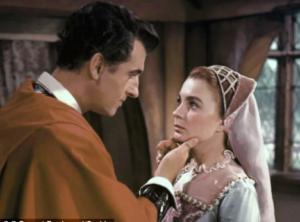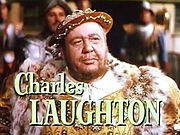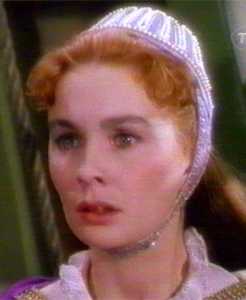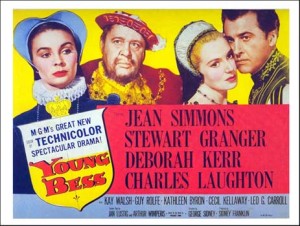Fans will know how much we love those old Warner Brothers films- even those without Errol Flynn. We are going to be starting a new feature, which will start as a monthly roundup of several Warner Archive releases. Ultimately we will work our way up to twice a month. Thanks to Warner Brothers who continues to support us by providing review samples. So here is our first take. If you want any of these discs for your collection (which you should), you can get either from WB or Amazon.com at the links we’ve included. This is a great way to support us as well, as we get a small commission which goes toward server costs, etc.
“I’d give my admiral the opportunities he never dared to dream about. I’d send him around the globe as the Portuguese do. I’d send him to the New World to let the Spaniards know that they are no longer masters of it.”—Young Bess (Lady Elizabeth)
Despite being originally from M-G-M, with all the high production values associated with that studio, Young Bess is one of the latest releases in the ongoing WB Archive Collection. I vaguely remember seeing the film in the theater when it was new in 1953 and perhaps sometime since on TV—I don’t recall—but, seeing it again, reminds me of its place in Hollywood’s history and how the treatment of these types of movies has changed over the years.
It’s not, be warned, a bloody epic of grand set pieces, graphic sex and wanton brutality, all shrouded in an unending din, à la the films of today. Far from it. It’s more like a stage play, with court intrigues, political discussions and behind-the-scenes romances, any possible set pieces occurring off-screen, as for example the referred-to happenings at sea. What is seen and heard on screen, though, is top-notch, with bright, clean and unshadowed interiors, historically inaccurate to be sure. Artists from Hollywood’s Golden Age were still around in 1953, adding touches of splendor, color and brilliance.
Charles Rosher is the cameraman. He won the first-ever Oscar for cinematography for Sunrise, the silent film of 1927, and would later shoot The Yearling, Show Boat (1951) and Scaramouche, among others. There was, in fact, much of merit to photograph in Young Bess. Although Cedric Gibbons was nominated for his Color Art-Set Direction, he would win instead for his B&W Julius Caesar, an Oscar shared with three other designers. Walter Plunkett, best known for his award-winning color costume design in Gone With the Wind, was nominated for Young Bess as well as for the B&W The Actress. And all of these visuals are supported by the sumptuous music of Miklós Rózsa, Oscar-nominated that year—not for this film but for Julius Caesar.
 Young Bess recounts part of the early life of Lady Elizabeth before she became Elizabeth I, inaccurately referred to as “Princess” Elizabeth in the film. The real Bess was not attractive, but this obviously caused only momentary concern for the producers who, flouting history, assigned the role to the beautiful Jean Simmons. After her noteworthy successes five or more years earlier in Great Expectations, Black Narcissus and Olivier’s Hamlet, Simmons dipped into an unfortunate interlude of merely “looking pretty” roles, and would not be redeemed as an actress until about the same number of years later, with the likes of The Big Country, Elmer Gantry, The Grass is Greener and, to a lesser degree, Spartacus, although she was always beautiful. Another similar interlude, including TV work, followed this second crest. As Leslie Halliwell remarked all so well, she made “films which have generally been unworthy of her talents.”
Young Bess recounts part of the early life of Lady Elizabeth before she became Elizabeth I, inaccurately referred to as “Princess” Elizabeth in the film. The real Bess was not attractive, but this obviously caused only momentary concern for the producers who, flouting history, assigned the role to the beautiful Jean Simmons. After her noteworthy successes five or more years earlier in Great Expectations, Black Narcissus and Olivier’s Hamlet, Simmons dipped into an unfortunate interlude of merely “looking pretty” roles, and would not be redeemed as an actress until about the same number of years later, with the likes of The Big Country, Elmer Gantry, The Grass is Greener and, to a lesser degree, Spartacus, although she was always beautiful. Another similar interlude, including TV work, followed this second crest. As Leslie Halliwell remarked all so well, she made “films which have generally been unworthy of her talents.”
Which can generally be said of her second-billed co-star and then husband Stewart Granger, who himself said, “I’ve never done a film I’m proud of.” To the contrary, there is nothing in Young Bess he should be ashamed of, though he is a bit wooden at times and his face could use a little more expression. He is clearly more limber in Scaramouche and The Prisoner of Zenda, as well he should be: he was one of the best swordsmen during his “Hollywood years,” roughly 1950 to 1955, from King Solomon’s Mines to Moonfleet.
 Charles Laughton reprises his role from The Private Life of Henry VIII as Henry, giving a reasonably good go at his dying scene, aided my Rózsa’s use of the plainsong Dies Irae. Missing here is some of the spark and vivacity, the rampant audacity, in his earlier portrayal of the beheading king. Other dying Henry VIIIs come to mind—just two for time’s sake: Montagu Love in the Errol Flynn version of The Prince and the Pauper, with his admonition that no sentiment should thwart a grasp for power, and Charlton Heston, more reconciled to approaching death, in a visually dirtier retelling of the Twain story in Crossed Swords.
Charles Laughton reprises his role from The Private Life of Henry VIII as Henry, giving a reasonably good go at his dying scene, aided my Rózsa’s use of the plainsong Dies Irae. Missing here is some of the spark and vivacity, the rampant audacity, in his earlier portrayal of the beheading king. Other dying Henry VIIIs come to mind—just two for time’s sake: Montagu Love in the Errol Flynn version of The Prince and the Pauper, with his admonition that no sentiment should thwart a grasp for power, and Charlton Heston, more reconciled to approaching death, in a visually dirtier retelling of the Twain story in Crossed Swords.
 The screen is graced by another beauty, Deborah Kerr as Catherine Parr who dies before plot’s end. Stewart Granger as adventurer Thomas Seymour suffers his own death on the scaffold, and Lady Elizabeth realizes she must face life without him. Better still, she must do her own thinking for the betterment of her nation, becoming, in the process, one of England’s greatest rulers, if not the greatest. The film ends with the young woman becoming Queen Elizabeth I, amid fanfares and regal processions.
The screen is graced by another beauty, Deborah Kerr as Catherine Parr who dies before plot’s end. Stewart Granger as adventurer Thomas Seymour suffers his own death on the scaffold, and Lady Elizabeth realizes she must face life without him. Better still, she must do her own thinking for the betterment of her nation, becoming, in the process, one of England’s greatest rulers, if not the greatest. The film ends with the young woman becoming Queen Elizabeth I, amid fanfares and regal processions.
Miklos Rózsa’s music goes beyond the call in capturing the splendor of this little chip of history. He conscientiously researched Tudor music of the period, much as he did to imbue El Cid with the flavor of the Spanish Middle Ages. There’s happy music for Elizabeth’s home at Hatfield, moody and dark strands for the intrigues and deaths and, as always in a Rózsa historical score, pomp and fanfares to accompany the regal goings-on. Necessary, too, is the source music, a ballad and dance during a banquet, which adds the illusion, at least, of authenticity.
